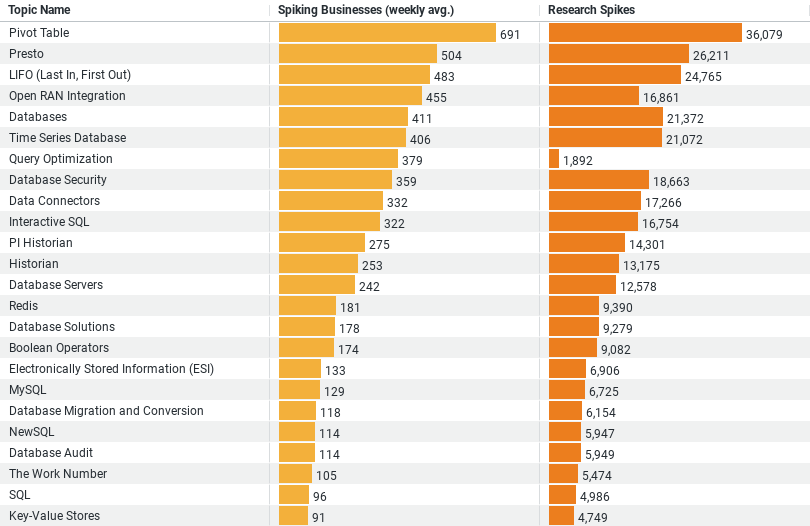Executive Summary: Database Research Trends in the Construction Industry
– Pivot Table
– Weekly Avg. Businesses: 691.25
– Research Spikes: 36,079
– Presto
– Weekly Avg. Businesses: 503.58
– Research Spikes: 26,211
– LIFO (Last In, First Out)
– Weekly Avg. Businesses: 482.52
– Research Spikes: 24,765
– Open RAN Integration
– Weekly Avg. Businesses: 455.03
– Research Spikes: 16,861
– Databases
– Weekly Avg. Businesses: 410.88
– Research Spikes: 21,372
The Construction Industry’s Growing Interest in Databases
In the ever-evolving landscape of the construction industry, staying ahead of the curve requires a constant influx of new knowledge and the ability to adapt to emerging technologies. One area that has seen a significant uptick in research activity is the realm of databases. The industry’s collective interest in data management and analysis is evident from the recent trends observed in various related topics.
Unpacking the Data Trends
A detailed analysis of research patterns reveals a keen focus on several key topics within the broader subject of databases. Among the most researched are Pivot Tables, Presto, LIFO (Last In, First Out), Open RAN Integration, and general Databases. Let’s delve into the specifics of each:
1. Pivot Tables
– Weekly Avg. Businesses: 691.25
– Research Spikes: 36,079
Pivot Tables are a cornerstone of data analysis, allowing users to summarize, sort, reorganize, group, count, total, or average data stored in a database. The construction industry’s high engagement with this topic underscores the importance of effective data manipulation and analysis tools.
2. Presto
– Weekly Avg. Businesses: 503.58
– Research Spikes: 26,211
Presto, a distributed SQL query engine, enables fast analytics on large data sets. Its popularity in the construction sector indicates a move towards advanced data querying techniques, which are essential for real-time data analysis and decision-making.
3. LIFO (Last In, First Out)
– Weekly Avg. Businesses: 482.52
– Research Spikes: 24,765
LIFO, an inventory valuation method, helps businesses manage costs and stock levels efficiently. The construction industry’s interest in LIFO points to a need for better inventory management practices, especially in managing raw materials and supplies.
4. Open RAN Integration
– Weekly Avg. Businesses: 455.03
– Research Spikes: 16,861
Open RAN (Radio Access Network) Integration is about creating flexible and interoperable network architectures. The construction sector’s focus here reflects an interest in leveraging cutting-edge communication technologies to improve project coordination and data flow.
5. Databases
– Weekly Avg. Businesses: 410.88
– Research Spikes: 21,372
General interest in databases highlights the sector’s recognition of the importance of robust data storage solutions. Effective database management systems are crucial for handling the vast amounts of data generated by construction projects.
Why Databases Matter in Construction
The construction industry generates enormous volumes of data daily, from project management logs to financial records, procurement details, and more. Efficiently managing this data is vital for several reasons:
– Enhanced Decision-Making: Databases allow for the storage and retrieval of large datasets, enabling better analysis and more informed decision-making. Tools like Pivot Tables facilitate the extraction of meaningful insights from complex data sets.
– Improved Project Management: Advanced querying engines like Presto help in quickly analyzing real-time data, thus improving project tracking and management. This is particularly important for large-scale projects where timely decisions can significantly impact outcomes.
– Cost Management: Methods like LIFO help in accurately assessing inventory costs, which is crucial for budgeting and cost control in construction projects. Efficient inventory management can lead to significant cost savings.
– Technology Integration: The interest in Open RAN Integration suggests a trend towards incorporating advanced communication technologies. This can improve on-site coordination, data sharing, and overall project efficiency.
The Future of Database Research in Construction
As the construction industry continues to evolve, the role of databases will only grow in importance. The current research trends suggest that businesses are increasingly aware of the benefits that robust data management and analysis tools can offer. From improving decision-making and project management to enhancing cost control and integrating new technologies, the focus on databases is a clear indicator of the industry’s forward-thinking approach.
Moreover, as more businesses adopt these technologies, we can expect to see even greater innovation in how data is used within the industry. This will likely lead to more efficient and effective construction practices, ultimately driving growth and profitability in the sector.
In conclusion, the construction industry’s burgeoning interest in databases is a positive sign of its commitment to embracing modern technologies. By continuing to invest in research and development in this area, the industry can unlock new levels of efficiency and success.
Company Sample Data
1. Company Size: Categorizes companies by the number of employees.
2. Spiking Businesses (weekly avg.): The average number of businesses showing a spike in research activity each week.
3. Percent of Total: The percentage of total businesses within each size category that are actively engaging in research.
Breakdown of the Data
1. Micro (1 – 9 Employees)
– Weekly Avg. Spiking Businesses: 310.37
– Percent of Total: 8.24%
Despite their small size, micro companies are actively participating in research, indicating that even the smallest firms recognize the importance of staying informed about database technologies.
2. Small (10 – 49 Employees)
– Weekly Avg. Spiking Businesses: 847.71
– Percent of Total: 22.49%
Small businesses make up a significant portion of the research activity. Their higher engagement compared to micro companies suggests that as companies grow, their capacity and need to engage in research also increase.
3. Medium-Small (50 – 199 Employees)
– Weekly Avg. Spiking Businesses: 965.37
– Percent of Total: 25.61%
This category shows the highest average weekly engagement, highlighting a peak in research activity. Medium-small businesses might be experiencing rapid growth, necessitating advanced data management solutions to sustain their expansion.
4. Medium (200 – 499 Employees)
– Weekly Avg. Spiking Businesses: 561.63
– Percent of Total: 14.90%
While still active, medium-sized companies have a lower engagement rate than medium-small businesses. This could indicate a stabilization phase where their initial rapid growth is tapering off, but they still need robust database solutions.
5. Medium-Large (500 – 999 Employees)
– Weekly Avg. Spiking Businesses: 348.81
– Percent of Total: 9.26%
Medium-large companies also show substantial engagement. This suggests ongoing efforts to optimize and manage the increasing complexity of their data needs as they approach large-scale operations.
Why This is a Trend Across Various Company Sizes:
The data reflects a clear trend: As companies grow, their need for robust database management and research into related technologies becomes more pronounced. Here’s why:
– Scalability Needs: Smaller companies initially focus on establishing their business. As they grow, the volume of data they handle increases exponentially, necessitating more advanced database solutions to manage this growth efficiently.
– Operational Complexity: With increased size comes increased operational complexity. Larger companies need more sophisticated tools to handle data analytics, inventory management, and communication systems, which drives research into these areas.
– Competitive Edge: Companies of all sizes are aware that staying ahead in the competitive construction industry requires leveraging the latest technologies. This drives continuous research and adoption of new database-related solutions.
– Resource Availability: Larger companies typically have more resources to allocate towards research and development. This is reflected in the higher engagement rates seen in small to medium-small businesses.
In conclusion, the dataset underscores a significant trend: regardless of size, companies within the construction industry are prioritizing research into database technologies. This trend is driven by the need to manage increasing amounts of data, optimize operations, and maintain a competitive edge in a rapidly evolving market. As businesses grow, their research activities intensify, highlighting the crucial role of databases in supporting business scalability and efficiency.



